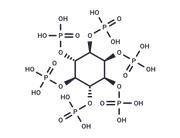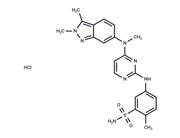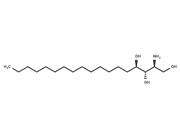| Name | Pazopanib |
| Description | Pazopanib (GW786034) is an inhibitor of protein tyrosine kinases that inhibits VEGFR1, VEGFR2, VEGFR3, PDGFRβ, c-Kit, FGFR1, and c-Fms (IC50=10/30/47/84/74/140/146 nM). Pazopanib has antitumor activity. |
| Cell Research | Pazopanib is prepared in DMSO and then diluted to final concentration in medium[1]. The effect of Pazopanib on cell proliferation is measured using 5-bromo-2-deoxyuridine (BrdU) incorporation method using commercially available kits. HUVEC is seeded in medium containing 5% fetal bovine serum (FBS) in type 1 collagen coated 96-well plates and incubated overnight at 37°C, 5% CO2. The medium is aspirated from the cells, and various concentrations of Pazopanib in serum-free medium are added to each well. After 30 min, either VEGF (10 ng/mL) or bFGF (0.3 ng/mL) is added to the wells. Cells are incubated for an additional 72 h and BrdU (10 μM) is added during the last 18 to 24 h of incubation. At the end of incubation, BrdU incorporation in cells is measured by ELISA. Data are fitted with a curve described by the equation, y=Vmax(1?(x/(K+x))), where K is equal to the IC50[1]. |
| Kinase Assay | VEGFR enzyme assays for VEGGR1, VEGFR2, and VEGFR3 are run in homogeneous time-resolved fluorescence (HTRF) format in 384-well microtiter plates using a purified, baculovirus-expressed glutathione-S-transferase (GST) fusion protein encoding the catalytic c-terminus of human VEGFR receptor kinases 1, 2, or 3. Reactions are initiated by the addition of 10 μL of activated VEGFR2 kinase solution [final concentration, 1 nM enzyme in 0.1 M 4-(2-hydroxyethyl)-1-piperazineethanesulfonic acid (HEPES), pH 7.5, containing 0.1 mg/mL bovine serum albumin (BSA), 300 μM dithiothreitol (DTT)] to 10 μL substrate solution [final concentration, 360 nM peptide, (biotin-aminohexyl-EEEEYFELVAKKKK-NH2), 75 μM ATP, 10 μM MgCl2], and 1 μL of titrated compound in DMSO. Plates are incubated at room temperature for 60 min, and then the reaction is quenched by the addition of 20 μL of 100 mM ethylene diamine tetraacetic acid (EDTA). After quenching, 20 μL HTRF reagents (final concentration, 15 nM Streptavidin-linked allophycocyanin, 1 nM Europium-labeled antiphosphotyrosine antibody diluted in 0.1 mg/mL BSA, 0.1 M HEPES, pH 7.5) is added and the plates incubated for a minimum of 10 min. The fluorescence at 665 nM is measured with a Wallac Victor plate reader using a time delay of 50 μs[1]. |
| In vitro | METHODS: SCLC cell lines NCI-H446 and NCI-H82 were treated with Pazopanib (0.01-30 µM) for 24-72 h. Cell viability was measured by CCK-8 assay.
RESULTS: Pazopanib significantly reduced the proliferation of NCI-H446 cells in a dose- and time-dependent manner, with an IC50 value of 1.05 µM at 24 h. Pazopanib also induced potent cell death in NCI-H82 cells in a dose- and time-dependent manner, with an IC50 of 1.298 µM at 24 h. Pazopanib significantly antagonized the proliferation of small cell lung cancer cells. [1]
METHODS: Human colorectal cancer cells HCT-116 were treated with Pazopanib (1-20 µM) for 3-24 h, and the expression levels of target proteins were detected by Western Blot.
RESULTS: Pazopanib significantly induced the expression of PUMA in a time- and dose-dependent manner. [2] |
| In vivo | METHODS: To assay anti-tumor activity in vivo, Pazopanib (30 mg/kg, suspended in 0.5% hydroxypropylmethyl cellulose and 0.1% Tween-80 in water) was administered by gavage to NOD-SCID mice bearing NCI-H446 xenografts The drug was administered once daily for two weeks.
RESULTS: Administration of Pazopanib significantly inhibited the growth of NCI-H446 xenografts. [1] |
| Storage | Powder: -20°C for 3 years | In solvent: -80°C for 1 year | Shipping with blue ice. |
| Solubility Information | Ethanol : < 1 mg/mL (insoluble or slightly soluble)
H2O : < 1 mg/mL (insoluble or slightly soluble)
DMSO : 20 mg/mL (45.71 mM)
|
| Keywords | FGFR | Autophagy | Platelet-derived growth factor receptor | Pazopanib | GW 786034 | c-Kit | PDGFR | Vascular endothelial growth factor receptor | CD117 | inhibit | VEGFR | Fibroblast growth factor receptor | GW-786034 | Inhibitor | SCFR |
| Inhibitors Related | Stavudine | Sodium 4-phenylbutyrate | Hydroxychloroquine | Guanidine hydrochloride | Taurine | Ferulic Acid | Curcumin | Paeonol | Naringin | Gefitinib |
| Related Compound Libraries | Membrane Protein-targeted Compound Library | EMA Approved Drug Library | Tyrosine Kinase Inhibitor Library | Drug Repurposing Compound Library | Inhibitor Library | FDA-Approved Kinase Inhibitor Library | Anti-Cancer Approved Drug Library | Bioactive Compounds Library Max | Anti-Cancer Drug Library | Anti-Cancer Active Compound Library |

 United States
United States



